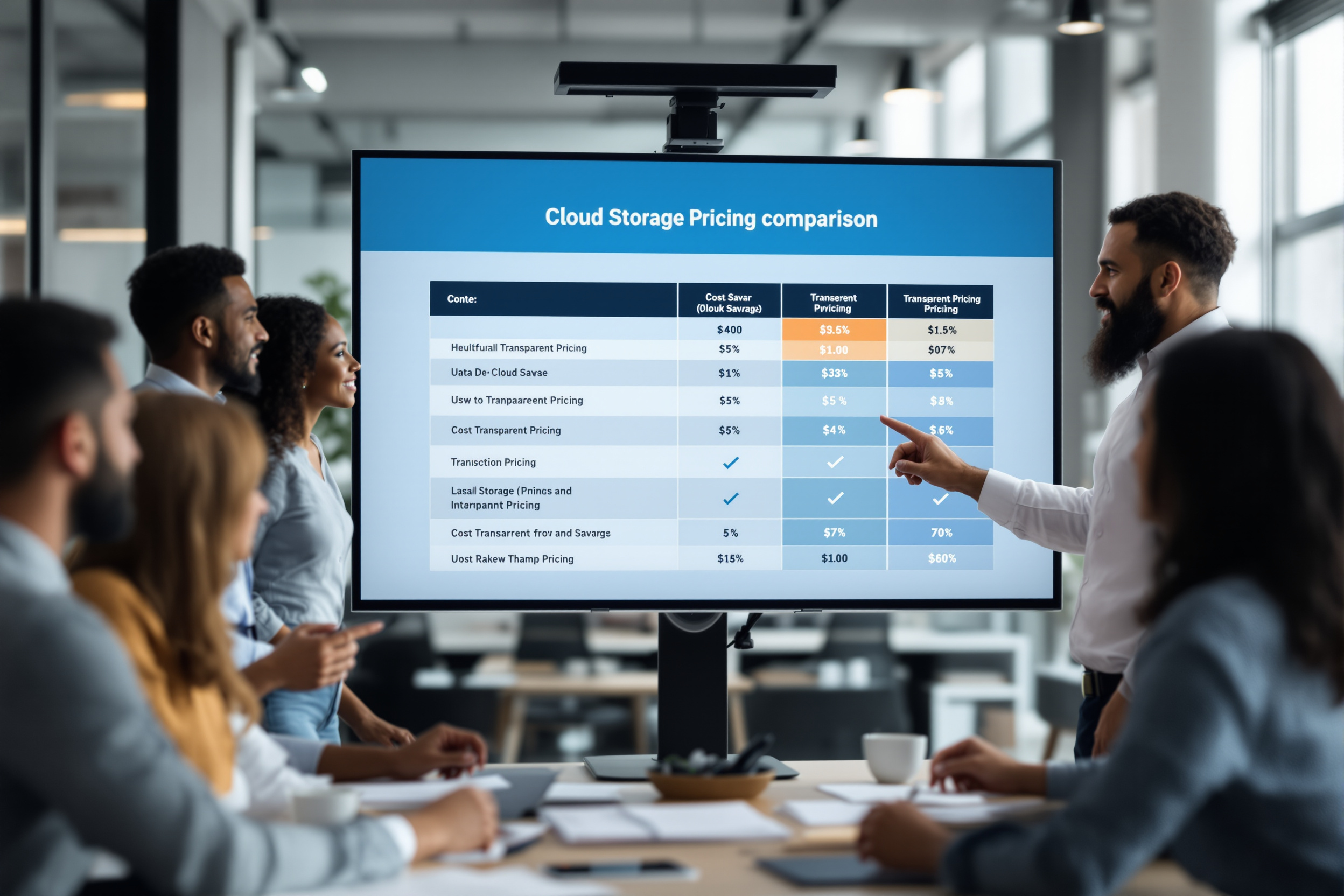Topics on this page
For years, IT leaders have relied on standard backup rules, but applying them to the cloud often results in budget overruns of 60-80%. Hidden egress fees and API call charges make cost forecasting impossible, while ransomware attacks increasingly target backup files, compromising an organization's last line of defense. This article outlines a modern framework for your backup rules, focusing on a predictable cost model and immutable storage. It provides a clear path to regain control over your data, secure your assets, and significantly reduce your total cost of ownership.
Key Takeaways
- Eliminate unpredictable cloud costs by adopting a storage model with zero egress fees and API charges, saving 60-80% on backup expenses.
- Neutralize ransomware threats by making immutable storage (Object Lock) a mandatory part of your backup rules, as 94% of attacks target backups.
- Improve recovery performance by up to 20% with an 'Always-Hot' architecture that makes 100% of your data instantly accessible without restore fees or delays.
Expose the Hidden Costs in Legacy Backup Strategies
Most enterprises discover their cloud backup strategy is broken when they receive a bill with massive egress fees. These data transfer costs can inflate monthly expenses by 3-5x, turning a predictable operational task into a significant financial burden. In fact, one audit of a major government agency projected egress fees would add $30 million annually to its cloud bill by 2025.
This cost unpredictability is the number one pain point for 60% of IT leaders using hyperscale clouds. Traditional backup strategy models did not account for paying a penalty every time you need to access or recover your own data. Vendor lock-in makes this problem worse, with punitive fees making it prohibitively expensive to switch providers.
These legacy approaches create strategic risk, trapping organizations with a single provider. This financial model directly undermines the core purpose of having a reliable and affordable backup plan. A new approach is needed to address these escalating costs.
Adopt a Predictable Cost Model to Eliminate Fees
A modern approach to backup rules starts with a cost-efficient-by-design storage architecture. Imagine a model with zero egress fees, zero API call charges, and no minimum storage durations. This transparent structure allows organizations to cut 60-80% of their typical cloud storage expenses, transforming budget planning from guesswork into a predictable science.
The key is choosing an S3-compatible alternative that works as a drop-in replacement for your existing tools. Full S3-API compatibility means your current applications, scripts, and backup software keep working without any code rewrites. You simply change the endpoint and protect years of investment in your existing workflows.
This model provides a built-in exit strategy, breaking the cycle of vendor lock-in. With no financial penalties for retrieving your data, you maintain full control and independence. This shift toward predictable cloud costs is the first step in building a resilient and financially sound disaster recovery plan.
Integrate Immutability to Neutralize Ransomware Threats
Cybercriminals are actively targeting recovery assets, with recent studies showing that 94% of ransomware attacks attempt to compromise backups. Attackers know that if they can disable your ability to restore, you are far more likely to pay the ransom. This makes immutable storage a non-negotiable element of modern backup rules.
Immutable storage, using features like Object Lock, creates a version of your data that cannot be altered or deleted for a set period. Here is how it protects your organization:
- It creates a WORM (Write-Once-Read-Many) state for backup files.
- It prevents encryption or deletion by malicious actors, even those with admin credentials.
- It ensures a clean, uncorrupted copy of data is always available for recovery.
- It helps meet compliance requirements for cyber insurance policies.
Organizations with compromised backups pay eight times more in total recovery costs than those whose backups remain untouched. By making an immutable backup a core part of your defense, you create a powerful last line of defense against extortion. This proactive security measure is essential for business continuity.
Leverage an 'Always-Hot' Architecture for Faster Recovery
Complex storage tiering often introduces unexpected delays and costs during a critical restore event. An "Always-Hot" object storage model eliminates this risk by ensuring 100% of your data is immediately accessible. This approach avoids restore surprises and keeps third-party backup tools stable and performant.
This architecture delivers up to 20% faster backup and restore performance compared to traditional cloud storage. Predictable low latency is critical when millions of files are involved or when facing a disaster recovery scenario. Fragile tiering policies can lead to API timeouts and hidden operational costs that an always-hot model avoids.
By simplifying operations, this model strengthens your recovery posture. There are no restore fees, no waiting for data to be rehydrated from a cold tier, and no surprises. This performance consistency is a cornerstone of an enterprise-ready backup solution.
Ensure Enterprise-Grade Compliance and Data Control
Modern backup rules must also address stringent regulatory requirements without adding complexity. Storing data with a provider that holds enterprise-grade certifications like SOC 2 and ISO 27001 is essential for regulated workloads. These certifications verify that the provider meets high standards for security, availability, and confidentiality.
Data control extends to physical location. For US-based companies, the ability to use country-level geofencing ensures data remains within predefined regions. This control is managed through a robust Identity and Access Management (IAM) system with multi-factor authentication and role-based access control (RBAC).
A first-class console UX allows teams to manage buckets, permissions, and lifecycle rules without deep API expertise. This combination of verified compliance and granular control gives you the tools to manage a secure and auditable cloud backup environment. This foundation of trust and verification is what separates consumer-grade storage from a true enterprise alternative.
Build Profitable Backup Services with Predictable Margins
For Managed Service Providers (MSPs), unpredictable costs directly erode profitability. A storage partner with a predictable pricing model is a significant competitive advantage. Eliminating egress and API fees allows MSPs to offer competitive Backup-as-a-Service (BaaS) and DRaaS pricing with stable, defensible margins.
A partner-ready platform should include these key features:
- A multi-tenant console for managing multiple clients with secure RBAC and MFA.
- Full automation capabilities via API and CLI for streamlined operations.
- Integrated reporting to monitor usage and costs accurately.
- Fast and simple onboarding to accelerate time-to-value for new customers.
This model allows MSPs to quote with confidence, knowing there will be no surprise bills to explain to clients. By passing cost savings on or increasing profitability, MSPs can grow their business on a stable financial foundation. This predictability is the key to scaling your service offerings.
Follow a 3-Step Migration Plan for a Seamless Transition
Transitioning to a cost-efficient S3-compatible alternative is a straightforward process that protects your past investments. A seamless migration minimizes risk and accelerates your time-to-value, with many organizations completing the switch in under an hour. The process requires no code rewrites for S3-native applications.
Your migration checklist should include three primary steps:
- Update Your Endpoint: Change the S3 endpoint in your existing backup software or scripts to the new provider. Your access keys and secret keys will work seamlessly.
- Copy Policies and Data: Replicate your bucket policies, IAM rules, and other configurations. Initiate data transfer using your preferred S3-compatible tools.
- Test and Validate: Perform a test restore of a critical dataset to verify the integrity of the backup and the functionality of the recovery process. According to one study, 46% of businesses never test their backups.
By following these practical steps, you can modernize your backup and recovery rules with zero disruption. Now is the time to take control of your cloud storage costs and prepare for the security challenges of tomorrow. Talk to an expert to calculate your savings.
More Links
The German Federal Statistical Office (Destatis) provides a press release on relevant statistics.
The German Institute for Economic Research (DIW) offers a publication suggesting that cloud solutions can increase productivity.
ComputerWeekly provides tips on creating a solid and cost-effective backup budget.
CloudComputing-Insider offers tips on how to reduce cloud costs when they increase.
FAQ
How can I reduce my cloud backup costs?
You can reduce costs by up to 80% by choosing a cloud storage provider that charges no egress fees, API call fees, or minimum storage durations. Using an S3-compatible service also eliminates the need for costly application rewrites during migration.
What makes a backup strategy effective against ransomware?
An effective anti-ransomware strategy includes immutable backups with Object Lock, which makes them unchangeable. It also follows the 3-2-1 rule, includes regular, automated testing of restores, and uses strong access controls like IAM with MFA.
Can I use my existing backup software like Veeam or NovaBackup?
Yes, a fully S3-compatible object storage solution works out-of-the-box with leading backup tools. Because it uses the standard S3 API, integrations are seamless, requiring only an endpoint change in your software's configuration.
What is 'Always-Hot' storage?
Always-hot storage means all your data is immediately available for access and recovery without any delays or extra fees associated with retrieving data from slower, cheaper 'cold' storage tiers. This simplifies operations and ensures faster restore times.
What compliance certifications should I look for in a backup storage provider?
For enterprise and regulated workloads, look for providers with certifications like SOC 2 and ISO 27001. These demonstrate a commitment to high standards of security, data privacy, and operational integrity.
How does a predictable cost model benefit MSPs?
A predictable model with no hidden fees allows MSPs to set stable pricing for Backup-as-a-Service (BaaS) offerings. This protects their margins, prevents surprise bills for clients, and provides a competitive advantage in the market.



.png)
.png)
.png)
.png)



.png)




%201.png)